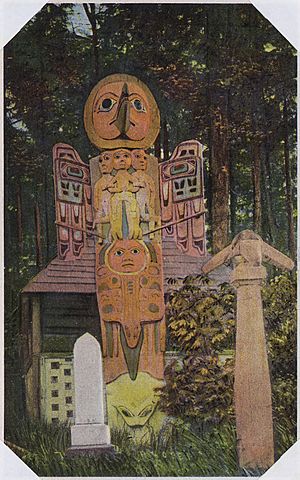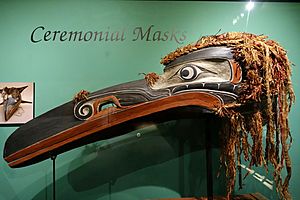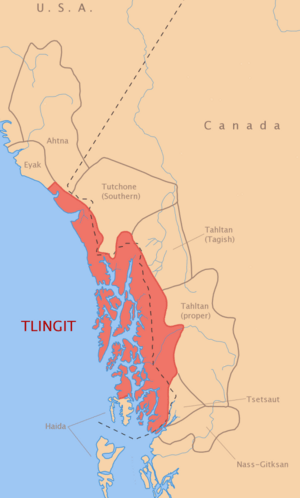Raven Tales facts for kids
Raven Tales are amazing traditional stories from the indigenous peoples of the Pacific Northwest Coast. These tales explain how the world, humans, and animals were created. You can also find similar stories among Athabaskan-speaking people and others. Raven stories are very popular with many First Nations groups. They are especially important to the Tsimshian, Tlingit, and Tahltan people.
Raven is known by many names across different cultures. He is a very important character in both written and spoken stories. These tales are passed down through generations of storytellers. They hold great cultural and historical meaning. It's good to know that some storytellers see these myths as more than just entertainment. They can be like cultural property belonging to a specific family or group. It's polite to ask permission before sharing a story that belongs to someone else.
Even though each culture tells different Raven stories, some things about Raven stay the same. Raven is always a magical being. He can change into a human, an animal, or even an object. He keeps many secrets and is often a trickster. He usually focuses on getting what he wants, especially if he's hungry! His stories explain how things in the world came to be. They also teach children how to behave. Raven often creates things by accident, just by trying to get what he wants. He's not usually trying to be helpful. Raven can be a hero in some stories and a troublemaker in others. He is both a hero and a funny character.
Stories where Raven is the hero are common in northern areas like British Columbia and Alaska. This includes the Tsimshian and Haida people. Similar tales about Kutkh are found in Chukchi cultures in northeast Asia. It's possible these stories were influenced by Native American tales.
The Haida people say Raven found the first humans hiding in a clam shell. He brought them berries and salmon to eat. The Sioux people tell a story about a white raven. This raven used to warn buffalo about hunters. One day, an angry hunter caught the bird. He threw it into a fire, which turned it black.
Contents
- Understanding Raven Tales
- Traditional Raven Stories
- Modern Adaptations of Raven Tales
Understanding Raven Tales
Raven tales often explain how humans came to be. However, they don't usually talk about how societies were organized. In stories that show how Native American societies grew, humanity itself is often the hero. Raven tales don't give a lot of detail about daily life or social rules.
Traditional Raven Stories
Athabaskan Tales
Athabaskan is a group of languages spoken by many people. These groups live in Western Canada and the American West. They are divided into Northern, Pacific Coast, and Southern Athabaskan language groups.
Cahto Stories
The Cahto are an indigenous group from California. They lived in Cahto Valley and Long Valley. The Cahto language is one of four Athabaskan languages spoken in northwestern California. Many Cahto speakers also spoke Northern Pomo.
How Raven Brought Light
One Cahto story tells how Raven created the world. Raven's father, Kit-ka'ositiyi-qa, taught him to be a creator. But Raven wasn't happy with his work. He made the world but couldn't give it light or water. He heard that light was hidden far away. So, Raven decided to travel there and steal it.
In the house of light, he found a young woman and her father. Raven played a trick. He turned into a tiny speck of dirt. He slipped into her drinking water and she swallowed him. The daughter became pregnant and had a very fussy baby. The baby cried all the time. It wanted to touch the bundles hanging on the walls.
The baby was given one bag to make it quiet. But when it got tired of playing, it let the bag go. The bag floated away through the smoke hole. Once it reached the sky, the bundle opened. It scattered stars across the sky. When the child cried for it back, he got the second bundle. He let it float away, releasing the moon. It happened again with the last bundle, which became sunlight. After bringing light to the world, Raven also flew out through the smoke hole.
Tahltan Stories
The Tahltan people had different customs based on where they lived. They believed some ancestors had special knowledge from before a great flood. Some ancestors used this knowledge for good. Others used it for bad. Raven is seen as the hero who fought against these evil ancestors.
In Tahltan stories, Raven is called Big-Crow (Tse'sketco).
The Birth of Big-Crow
The Tahltan say Big-Crow was born in the northern Tlingit country. He was the youngest of many brothers. He was raised speaking the local language. He was separated from his father at birth. His father is not mentioned in their stories.
As Raven grew up, he traveled alone by canoe along the seashore. He stopped at villages. If he saw people taking advantage of others, he would take away their power.
Raven traveled for many years along the Tlingit coast. He went south, then turned around and went north again. He did this for several years. Once his work along the coast was done, he went inland. He traveled along the Stikine River to its source. He also traveled the Nass, Skeena, and Taku rivers. He never stayed in one place long. He always stayed near waterways. On his inland journeys, he met the Kaska Dena, the Haida, and other nations.
Later in life, after doing all he could, Raven went back to the coast. He followed the setting sun until he mysteriously disappeared. People thought he might have gone to live with ancient gods on an island far out in the ocean. They believed weather was created there.

After "The Birth of Raven," many other stories follow:
- "Origin of the Tides"
- "Origin of Fresh Water"
- "Origin of Olachen"
- "Origin of Daylight"
- "Raven and the Salmon"
- "Raven Creates the Salmon and Teaches the People"
- "Raven Institutes Birth and Death"
- "Raven and the Grizzly-Bear"
- "Raven Paints the Bird"
- "Raven Paints his Men for War"
- "The Tree Eats the Bird"
- "Raven Kills Pitch-Man"
- "Raven and His Sister"
- "Raven Tries to Marry a Princess"
- "Raven in the Country of the Tahltan"
- "Raven and Kanu'gu"
- "Raven and the Haida"
- "Raven Institutes the Kuwega'n Ceremonies"
- "Raven Makes the Wolf Women Good-Looking"
- "Raven Considers how to Provide for the People"
- "The Origin of Birth and Death"
- "Raven Curtails the Powers of Game"
- "Raven Steals Fire"
- "Raven Ballasts the Earth"
- "Raven Makes Lakes"
- "Raven Makes Mud"
- "Raven Creates Bear"
- "Raven and Bear-Man"
- "Raven and E'dista or Big-Toad"
- "Raven and Rabbit-Man Kextsaza"
- "Raven and Crow"
- "Raven and His Blanket"
- "Raven Loses his Nose"
- "Raven and the Ghosts"
- "Raven and Porcupine Make the Seasons"
Raven also appears in other stories not directly about him. In the story of the 'Warm and Cold Wind People,' someone, possibly Raven, decided that people should send out the winds. He also appears in "The Great Flood." This story tells how evil ancestors were removed. They had taken away the sun, moon, and Dipper, which were lost during the flood.
Northern Athabaskan Stories
- "Great Raven Makes The World"
- "Raven Steals The Light"
- "When Raven Was Killed"
- "How Raven Killed The Whale"
- "Raven and Mink"
- "Raven Lost His Eyes"
- "Raven and Goose-Wife"
Inuit Tales
The Inuit people live in Alaska, Northern Canada, and Greenland. In Inuit culture, the owl, fish, and raven are very important. Ravens are common in Inuit art. They have several stories about Raven's birth. Raven often shares a close friendship with the owl.
The Inuit say Raven was born from darkness. He was weak and lost at first. As he traveled, he realized he was the Raven Father, Creator of All Life. Once he understood this, he gathered his strength. He flew out of the darkness to a new place he called Earth. But he was still alone, so he created plants. As he explored, he found a man, the first of the Inuit. Raven fed the man and taught him to respect the world. Soon, a woman appeared. Raven taught them both how to make clothes, build shelters, and create canoes. As they had children, Raven cared for and taught them.
- "Inuit Story of Owl and Raven"
- "Raven's Great Adventure"
- Owl Paints the Raven by Ningeokuluk Teevee
Aleut Stories
Stories from the Aleut people include:
- "Princess Raven"
- "Raven and His Grandmother"
- "Raven's Great Adventure"
Cup'ik (Yupik) Stories
Raven is called Tulukaruq by the Yupik people. He is seen as a kind culture hero who helps people.
- "Raven Seeks A Wife"
- "Raven and Goose-Wife"
- Ellagpiim Yua
- "Raven's Daughter"
- "How The Owl Got Its Grey Spots"
Haida Tales
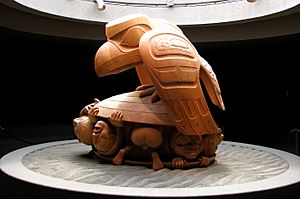
The Haida people traditionally live in the Haida Gwaii islands in British Columbia and southern Alaska. To the Haida, Raven brought light to the world. Before Raven, the world was just a giant flood. Raven was the Maker of Things, a Transformer, Magician, and Healer. Raven was bored with a world of only water. He decided to fly as the waters went down. When he got hungry, land formed so he could rest and find food.
Then he heard strange sounds from a giant clam shell. Raven was confused. He started singing to the clam shell, hoping his beautiful voice would calm it. Finally, a small creature came out of the shell. It had long black hair, a round head, smooth brown skin, and two legs like Raven, but no feathers. These were the first people.
When Raven got bored with them, he thought about putting them back in the shell. Instead, he found female humans trapped in a chiton (a type of sea creature). He freed them. He was entertained as the men and women met and started to interact. Raven felt responsible for them and protected them. Many Haida myths show Raven as a provider for humans. He combines the roles of creator and trickster.
Other versions tell a different creation story. When the earth was only sky and water, there was a single reef. All the great beings lived there. The greatest lived at the top, and the weakest at the bottom. But Raven flew above them all and couldn't find a place to land. So he went to the sky country. There he met the Chief's daughter, who had just had a child. While it was dark, Raven took over the baby's body. He planned to take its place as the Raven Child.
Sun, Moon, and Stars
An old story from Haida Gwaii tells how Raven helped bring the Sun, Moon, Stars, Fresh Water, and Fire to the world:
Long ago, at the start of the world, Gray Eagle guarded the Sun, Moon, Stars, fresh water, and fire. Gray Eagle disliked people so much that he kept these things hidden. People lived in darkness, without fire or fresh water.
Gray Eagle had a beautiful daughter. Raven fell in love with her. At first, Raven was a snow-white bird. Gray Eagle's daughter liked him because he was white. She invited him to her father's longhouse.
When Raven saw the Sun, Moon, stars, fresh water, and fire hanging in Eagle's home, he knew what to do. He waited for a chance to grab them when no one was looking. He stole all of them, and a burning stick of fire too. He flew out of the longhouse through the smoke hole. As soon as Raven was outside, he hung the Sun in the sky. It made so much light that he could fly far to an island in the middle of the ocean. When the Sun set, he put the Moon in the sky and hung the stars in different places. By this new light, he kept flying. He carried the fresh water and the stolen fire.
He flew back over the land. When he reached the right spot, he dropped all the water he had stolen. It fell to the ground and became all the fresh-water streams and lakes in the world. Then Raven flew on, holding the burning stick in his beak. The smoke from the fire blew over his white feathers and turned them black. When his beak started to burn, he had to drop the fire. It hit rocks and hid inside them. That's why if you strike two stones together, sparks of fire appear.
Raven's feathers never became white again after the smoke blackened them. That is why Raven is now a black bird.
Other Haida stories include:
- "The Coming of the Salmon"
- "The Raven and the First Men"
- "The Bear and His Indian Wife"
Heiltsuk (Bella Bella) Tales
The Heiltsuk people were once known as the Bella Bella. They lived along the central coast of British Columbia. To them, Raven was called the Real Chief or He'mask.as. They respected Raven as a kind figure. He helps people, but he is also a trickster. His thoughtless actions sometimes get him into trouble.
- "The World is Burnt" (Raven predicts a world fire)
Kwakwakaʼwakw Tales
Another story comes from the Kwakiutl or Kwakwakaʼwakw of British Columbia. They would expose boys' placentas to ravens. This was done to encourage future visions. This links the raven with prophecy, similar to traditions in Scandinavia.
- "Wakiash and the First Totem Pole"
Miwok Tales
The Miwok people are divided into three groups: Coast Miwok, Lake Miwok, and Plains and Sierra Miwok.
The Miwok territory is next to the Maidu, Yokuts, Washoe, and Mono. The Interior Miwok live mainly on the western side of the Sierra Nevada mountains. Their Sierra territory stretched from the Cosumnes River in the north to the Fresno River in the south.
Among the Northern Miwok in what is now Central California, a Raven story begins with a world covered in water. Only a single mountain top was dry, where people had gathered during the flood. As the waters went down, people tried to come down the mountain. But the land was so muddy that those who tried would sink. Wherever a person sank, a raven would stand on that spot. One raven at each hole. Once the ground became hard, the raven turned into a person. This explains why Miwok people have dark skin.
Nuu-chah-nulth Tales
The Nuu-chah-nulth people speak a southern Wakashan language. They are also known as the Nootka.
- "Octopus and Raven"
Ojibwe Tales
The Ojibwe are also known as Anishinaabe (the name of their language), Ojibwe, or Algonquin.
The Saulteaux or Plains Ojibwa, also called Bûngi Indians, live on the Long Plains Reserve in Manitoba.
- "Turtle's War-Party"
- "The Man and the Ravens"
Puget Sound Stories
Another Raven story from the Puget Sound region says that "Raven" originally lived in the land of spirits (or "bird land"). This land existed before the human world. One day, Raven got so bored with "bird land" that he flew away. He carried a stone in his beak. When Raven got tired of carrying the stone, he dropped it. The stone fell into the ocean and grew. It became the solid ground where humans now live.
- "The Legend of Raven"
Pima Tales
- "The Children of Cloud"
Quileute Tales
The Quileute are a Native American group in western Washington state. Their language belongs to the Chimakuan languages family.
The Quileute name for Raven is Báyaḳ (By-yuhk).
The Quileute Indians were the southernmost group on the Pacific Coast with Raven stories. While their main hero was Kweeti, not Raven, Kweeti's stories are very similar to Tlingit stories about Raven.
Among the Quileute, Raven is used in scary stories for children. These stories explain why Raven's feet look the way they do. Other stories teach children to be generous, not selfish. They also teach to be true to themselves and work hard, instead of taking shortcuts. In their stories, Raven is often punished. Or he sees suffering among the people he cares for because of his tricks.
- "Báyaḳ and Ákil" (Raven and Bear)
- "Báyaḳ and Kwíd" (Raven and Fishduck)
- "Báyaḳ and Pákwad" (Raven and Skatefish)
- "Báyaḳ and Píxťadax" (Raven and Eagle)
- "The Bungling Host"
- "Duskeah"
- "Raven lights the world: Hungry for clams"
Salishan Tales
Coeur d'Alene Stories
The Coeur d'Alene live in villages along the Coeur d'Alene, Saint Joe, Clark Fork, and Spokane Rivers. They also live on the shores of Lake Coeur d'Alene, Lake Pend Oreille, and Lake Hayden. This area is now northern Idaho, eastern Washington, and western Montana.
- "Circling Raven and the Jesuits"
Squamish Stories
The Squamish see Raven as a symbol of the Creator. Even today, he is part of their teachings.
- "Raven: The Brave Warrior"
- "Raven Proposes and is Accepted"
- "Raven and the Fish Melt"
- "The Mink, the Raven and the Sea Eggs"
Shishalh Tales
Stories from the Shishalh or Schelt include:
- "The Seal and the Raven"
Tlingit Tales
Tlingit territory is in Southeast Alaska. Most of their land is now in Canada.
The Tlingit have many names for Raven. The most common is Yéil. Other names are Yéil Tl’éetl’i, g̱uneit, gidzanóox’, and yéilk’. The story of his name is that the tide woman gave it to him. In Tlingit, the word "Yéil" also means trickery, lies, and copying.
In Tlingit culture, there are two different Raven characters. They are not always clearly separated. One is the creator Raven. He is responsible for making the world and bringing light to darkness. The other is the childish Raven. He is always selfish, sly, tricky, and hungry. When the Great Spirit created everything, he kept them separate. They were stored in cedar boxes. The Great Spirit gave these boxes to the animals that existed before humans. When the animals opened the boxes, all the things that make up the world came into being. The boxes held things like mountains, fire, water, wind, and seeds for all plants.
One such box was given to Seagull. It held all the light of the world. Seagull loved his box and refused to open it. He clutched it under his wing. All the people asked Raven to convince Seagull to open it and let out the light. Raven begged, demanded, flattered, and tried to trick him, but Seagull still refused. Raven became angry and frustrated. He stuck a thorn in Seagull's foot. Raven pushed the thorn deeper until the pain made Seagull drop the box. Then, out of the box came the sun, moon, and stars. They brought light to the world and allowed the first day to begin.
Theft of Water
Raven continued to use tricks to bring water. He also used them to give people, animals, and other things in the world certain features. Many versions of Raven's theft of water are told. All of them focus on Raven tricking the owner of the water. In one story, Raven makes the owner believe he wet his bed in his sleep. Raven threatens to shame him unless he shares his water. In another story, Raven puts ash on his tongue. This tricks the owner into believing Raven's extreme thirst is not satisfied. Instead of drinking the water, Raven collects it in a seal's bladder hidden under his clothes. He then runs away with all of it.
Tsimshian Tales
To the Tsimshian, Raven was known as Txamsem or ganhada, the Clever One. He had a brother named Lagabula, or Lazy One.
The two were born in a kelp patch. They were adopted by a Chief's wife and a magical being from the Prince Rupert Harbour area. At the time they were born, daylight didn't exist; it was only dusk. Some stories say they were from Gispaxloats. They were born to a Gispaxloats Chief who married a beautiful princess.
On their journeys, they traveled to a mountain at the head of the Nass River. Txamsem could change into anything. He often took the form of a human or a bird. He turned himself into a pine needle. The daughter of the Chief who guarded daylight ate him. She then gave birth to him as a baby. The baby cried constantly to play with daylight. As soon as it was given to the baby as a playful ball, he changed back into Raven. He flew away with it. He traveled back up the Nass River with daylight and released it. It immediately lit up the river and spread all over the world.
Raven is the most important culture hero for many indigenous peoples of the Pacific Northwest. There are many stories about Raven and his adventures. He always wants to get whatever he desires. Most Raven tales show how Raven uses force or trickery to get someone else to give up something he wants. In his many stories, Raven claims daylight, water, fire, ocean waves, the olachen (a type of fish), salmon, soil, and even the weather.
Through the Raven tales, people can explain why their environment is the way it is. They link Raven or his friends to the cause of various things in the world.
Some stories explain how dangerous animals were created from objects. Others suggest that men, animals, and objects could turn to stone. Other stories explain how important places got their names and how geographical features came to be.
There is a small mention that Raven was an ancestor of the Raven Clan. But there are no other direct links between Raven and the ancestry of the Indian people.
- "The Beginning"
- "The Theft of Light"
- "Raven Becomes Voracious"
- Origin of Txa'msem
- Origin of daylight
- Stone and Elderberry Bush
- Origin of fire
- Txa'msem uses the sinews of the tomtit
- Origin of tides
- Giant gambles with Gull
- Giant obtains the olachen
- Giant learns how to cook olachen
- Giant and the gulls
- Txa'msem and the steelhead-salmon
- Txa'msem and Lagobola’
- Txa'msem and the crab
- Origin of the bullhead
- Txa'msem frightens away the owners of a whale
- Txa'msem finds a beautiful blanket
- Txa'msem and his slave
- Txa'msem kills his slave
- Fishermen break off Txa'msem jaw
- Txa'msem and the Hunter
- Txa'msem and the children
- Txa'msem and the salmon woman
- Txa'msem makes war on the south wind
- Txa'msem makes a girl sick and then cures her
- Txa'msem pretends to build a canoe
- Txa'msem visits Chief Echo
- Txa'msem kills Little Pitch
- Txa'msem kills Grizzly Bear
- Txa'msem kills Deer
- Txa'msem imitates Chief Seal
- Txa'msem imitates Chief Kingfisher
- Txa'msem imitates the thrush
- Txa'msem and Cormorant
- Txa'msem returns to the Wolves
- Txa'msem invites the monsters
- The further history of Txa'msem
- Raven obtains fresh water
- Raven paints the birds
- Raven carves salmon out of various kinds of wood
- Raven marries the dead twin
- Raven abducts the daughter of the salmon chief
- Raven gets the soil
- Why Crow and Raven are black
- Raven and Eagle gather red and black cod
- Raven marries Hair-Seal-Woman
- Raven steals salmon eggs
- Raven steals his sisters' berries
- Raven's gizzard is torn out
- Raven kills the seals
- Raven pretends to be dead
- Raven burns his sister's groins
- Raven deserts Master Fisherman on a lonely island
- War with the Thunderbird
- Wren kills the Bear
- Raven pulls off the arm of a chief
- Raven is set adrift
Zuni Tales
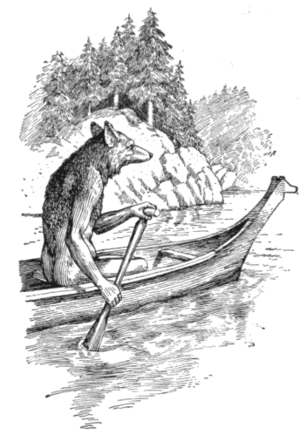
The raven is not a traditional sacred object for the Zuni. However, he and the Macaw are important in the Zuni migration story. Raven is often carved in their artwork, usually from black marble.
The Zuni see Raven as a prankster. But he does not have the negative traits they link with the coyote. Raven's best qualities are his ability to help people overcome their problems. He gently reminds them that anything they are brave enough to face, they also have the power to change.
- "Origin of Raven and the Macaw"
- "The Search for the Corn Maidens"
Modern Adaptations of Raven Tales
Many children's books and picture books have retold traditional Raven Tales. These new versions have been criticized for showing a much "nicer" Raven. They often leave out the original greedy trickster side. In some stories, Raven acts for the good of people, not just for himself. In other stories, Raven refuses to use force. Trickery is sometimes replaced with magic. These newer tales are also written in a Western style, not like traditional Native American storytelling. This can sometimes suggest that native storytellers' style is not as good.
In 2004, The Smithsonian Institution helped Chris Kientz create a series of animated TV shows. These half-hour programs were for school children. They were a fun way to teach kids about aboriginal folklore. The show Raven Tales was made by New Machine Studios with producer Winadzi James. It aired for two seasons with 26 episodes.
In 2010, Matt Dembicki created a graphic novel of trickster stories. He made sure to keep the cultural meaning of the stories. He worked with 21 Native American storytellers. They were paired directly with several graphic designers.


